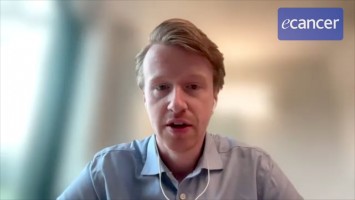The ultra-low pass whole genome sequencing is a new technology that has been invented by the liquid biopsy corps at the Broad Institute in Cambridge. It’s a very interesting tool because we can sequence the very low pass, it’s 0.1x. What we get from that for the cell-free DNA actually is we can detect the copy number abnormalities and from that we can infer the tumour fraction within the cfDNA. So we sequenced 88 samples from myeloma patients, the cfDNA, and we found in 75 of them more than 3% of tumour DNA within the cfDNA. So it’s a way to assess if there is enough tumour DNA in the cfDNA to further sequence the samples basically.
What made you choose to focus on this particular area?
Multiple myeloma is characterised by clonal heterogeneity and clonal evolution so the clonal evolution induces progression of the disease and relapse after treatment and treatment resistance. So there is a real interest to be able to follow the patients longitudinally for their genomic features across the course of the disease. So what we did here is we used the cfDNA liquid biopsy to assess the genomic abnormalities in myeloma patients. Before that, the first study that we did and we presented here, was to compare cell free DNA to the bone marrow tumour cell DNA and we did the whole exome sequencing for that. So we had ten patient samples with matched cfDNA and the bone marrow tumour cells, we applied the whole exome sequencing on them and we compared them. So basically in terms of copy number alterations and the main somatic mutations it was pretty comparable and we could identify in both compartments the mutations, so the copy number alterations.
What’s interesting as well is that we looked at the clonal heterogeneity in these samples and we inferred the clonal and subclonal mutations in both of them. We could identify 100% of the clonal mutations in both cfDNA and the bone marrow tumour cells and it was about two-thirds of the subclonal mutations. Which is interesting because it means that, first, it’s a good proxy, cfDNA is a good proxy of the bone marrow tumour cells first but it also can improve the clonal heterogeneity definition in multiple myeloma.
What are the implications?
We believe that these need to be further assessed in prospective clinical trials and the goal would be to have sequential samples across the course of the disease and being able in that way instead of doing multiple bone marrow biopsies, for example, and being able to follow the clonal evolution of the patients and to potentially detect mutation resistance early on and be able to adapt the therapy and the treatments based on that. So it’s really like the possibility to do multiple blood samples, to sequence these samples and have a real vision of multiple myeloma at the genomic level.
Is this better for the patient?
Absolutely. So instead of doing multiple biopsies we just need a simple blood sample to do this sequencing and we have all the mutations that are present in the bone marrow and even potentially more because the bone marrow biopsy is just a one site biopsy and in the blood we can potentially get different clones that are in separate sites. So it can even improve the definition of the clonal heterogeneity.
What about cost?
The ultra-low pass whole genome sequencing is a very low cost, actually, technology; it’s only like $20 per sample which is very affordable. Then a targeted deep sequencing could be also low cost based on new technologies that we have and can sequence very deep for affordable cost now.
Any further thoughts?
Looking for what you develop this in clinical trials while working on that with the French team actually now so hopefully we’ll be able to present new data about this very exciting technology in the near future.








